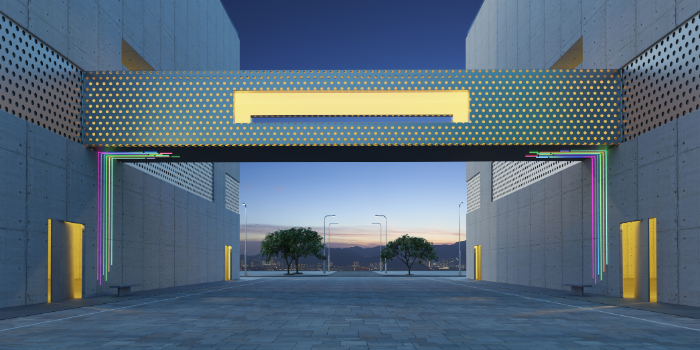
The Dawn of Tech-Driven Architecture
Imagine stepping into a world where the buildings around you aren't just structures; they're a blend of creativity, innovation, and technology. This is the realm of modern architecture, where every curve, corner, and column is influenced by technological advancements. From the drawing board to the skyline, technology has transformed the way architects dream and build. It's a fusion of tradition and innovation, where the past and the future meet in the designs of today.
Now, think of a building that adapts to the weather, conserves energy, and even communicates with its inhabitants. This isn't science fiction; it's the present, thanks to tools like AI, BIM, and virtual reality. These technologies are not just add-ons; they're essential elements that shape contemporary architecture, making buildings smarter, greener, and more responsive.
As we embark on this exploration of technology's influence on architectural design, we're not just talking about the future. We're discussing the now — the exciting intersection where architecture meets innovation, pushing the boundaries of what's possible in creating spaces that inspire, function, and protect. Welcome to the digital revolution in architecture, where every design tells the story of technology and creativity coming together to redefine our world.
AI in architecture is like having an incredibly smart assistant who never sleeps. It's changing the game, making the design process more efficient and creative. Picture AI helping architects sift through endless design options, optimizing building layouts for energy use, and even predicting how a space will age over time. It's about making smarter decisions faster.
AI also steps in to keep people safe, using data to foresee potential construction hazards before they happen. This isn't just about saving time or money; it's about protecting lives. Plus, AI's role in selecting sustainable materials helps architects build greener, more sustainable spaces without sacrificing design.
What's truly fascinating is AI's ability to learn and adapt. Each project feeds into its knowledge base, making the next project even more informed. It's a cycle of continuous improvement, pushing the boundaries of what we think is possible in architecture.
In essence, AI in architecture isn't just a tool; it's a collaborator that brings out the best in human creativity, helping architects explore uncharted territories in design while staying grounded in practicality and safety. This synergy between human ingenuity and artificial intelligence is paving the way for a new era in architectural design, where the buildings of tomorrow are being shaped by the technologies of today.

Building Information Modeling (BIM) isn't just changing project management in architecture; it's revolutionizing it. Imagine a tool so powerful that it allows architects, engineers, and construction teams to work together seamlessly from miles apart. BIM does just that by creating detailed digital representations of physical and functional characteristics of places. This isn't just about 3D modeling; it's about creating a shared knowledge resource that spans the entire project lifecycle, from conception to demolition.
With BIM, everyone involved in the construction process can access, update, and share data in real time. This level of collaboration cuts down on misunderstandings and errors, saving time and money. More than that, it allows for more sustainable building practices by enabling architects to simulate a building’s performance before it’s even built. This means better energy efficiency, lower costs, and a smaller carbon footprint.
BIM also paves the way for more innovative design solutions. By providing a comprehensive view of the entire project, architects can explore more creative options without losing sight of practical constraints. It’s like having a sandbox where the limits are defined, but within them, creativity can run wild.
In essence, BIM is not just a tool but a new way of thinking about building design and construction. It encourages collaboration, innovation, and efficiency, making it an indispensable part of the modern architectural landscape. Through the lens of BIM, the future of architecture looks not just brighter but smarter, with every project managed more effectively and sustainably.
Virtual Reality (VR) and Augmented Reality (AR) are opening up new frontiers in architectural design visualization, adding a depth and interactivity that was once the stuff of imagination. Imagine slipping on a VR headset and stepping inside your future home or office, walking through rooms, and experiencing the space around you, all before the first foundation stone is laid. This immersive experience allows architects, clients, and stakeholders to truly feel the space, identifying potential issues and opportunities for improvement early in the design process.
AR takes this a step further by overlaying digital information onto the real world. Imagine pointing your tablet at a construction site and seeing the completed building superimposed over the current view. This not only aids in understanding how a building will sit within its environment but also enhances communication and decision-making.
Both VR and AR transform abstract plans into tangible experiences, making complex architectural concepts easier to grasp. They foster a collaborative environment where feedback can be instant and changes made swiftly, reducing errors and aligning expectations. This leap in visualization isn't just about making things look good; it's about creating a more intuitive, efficient, and engaging design process. As these technologies continue to evolve, they promise to further bridge the gap between imagination and reality, enabling architects to push the boundaries of design and clients to fully realize their visions.
As we look towards the horizon, the future of architectural design with technology promises an era where the boundaries between digital and physical blur. We're not just talking about incremental changes; we're envisioning a seismic shift in how we conceive, develop, and interact with our built environment.

Imagine buildings that adapt to changing weather conditions in real-time, thanks to smart materials and IoT integration, or structures that repair themselves using advanced robotics and materials science. The potential for 3D printing in architecture goes beyond prototypes, venturing into constructing entire buildings with unprecedented designs and efficiency.
The integration of AI will continue to evolve, offering more than just predictive analytics for project management. It could lead to autonomous design processes where AI collaborates with human architects to generate creative solutions that balance aesthetic appeal with sustainability and functionality.
Furthermore, as VR and AR technologies become more refined, they will offer even more immersive and interactive ways to visualize and modify designs in real-time, bridging the gap between imagination and realization with unprecedented fidelity.
The convergence of these technologies doesn't just mean smarter ways of building. It heralds a future where architecture seamlessly integrates with the environment and responds dynamically to the needs of its inhabitants. We're stepping into an age where technology empowers architects to dream bigger, design smarter, and build in harmony with nature and humanity.
As these technologies continue to mature and become more accessible, they will undoubtedly shape the next frontier of architectural innovation, making today's cutting-edge concepts tomorrow's reality. This is more than a trend; it's a transformation of the architectural landscape, promising a future where our buildings are as alive and responsive as the communities they house.
Integrating technology in architecture brings its set of challenges and ethical considerations. As we embrace AI, BIM, VR, and AR, concerns about data privacy and security come to the forefront. Sensitive information about buildings and their inhabitants needs protection against cyber threats. The reliance on technology also raises questions about the digital divide. Not every firm or country has equal access to these advanced tools, potentially widening the gap between the technologically advanced and the rest.
Moreover, the automation of design and construction processes could displace traditional jobs, sparking debates about the future of craftsmanship in architecture. Ethical use of technology also includes considering its environmental impact, ensuring that digital advancements do not come at the expense of sustainability.
To navigate these challenges, the architectural community must advocate for responsible use of technology, emphasizing education, inclusivity, and ethical standards. It's about finding a balance, ensuring that technological advancements enhance rather than overshadow the human aspect of architecture.
The journey through the influence of technology on architectural design highlights a future brimming with possibilities. From AI to VR, the tools at our disposal are reshaping not just the buildings we create but also how we create them. They promise a world where designs are more sustainable, efficient, and in tune with human needs. Yet, as we navigate this digital frontier, the architectural community must tread carefully, balancing innovation with ethical considerations and inclusivity. Embracing technology means not just harnessing its power for creativity and efficiency but also ensuring it serves the greater good, making our built environment more accessible, safe, and sustainable for all. As we look forward, the fusion of technology and architecture holds the promise of a brighter, more connected world, built on the foundations of human ingenuity and digital advancement.